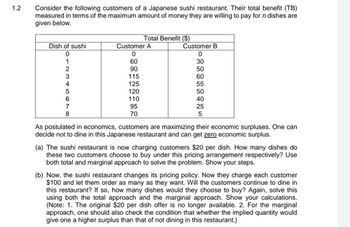
ENGR.ECONOMIC ANALYSIS
14th Edition
ISBN: 9780190931919
Author: NEWNAN
Publisher: Oxford University Press
expand_more
expand_more
format_list_bulleted
Question

Transcribed Image Text:1.2
Consider the following customers of a Japanese sushi restaurant. Their total benefit (TB)
measured in terms of the maximum amount of money they are willing to pay for n dishes are
given below.
Dish of sushi
0
1
2
3
4
5
6
7
8
Customer A
0
60
90
Total Benefit ($)
115
125
120
110
95
70
Customer B
0
30
50
60
55
50
40
25
5
As postulated in economics, customers are maximizing their economic surpluses. One can
decide not to dine in this Japanese restaurant and can get zero economic surplus.
(a) The sushi restaurant is now charging customers $20 per dish. How many dishes do
these two customers choose to buy under this pricing arrangement respectively? Use
both total and marginal approach to solve the problem. Show your steps.
(b) Now, the sushi restaurant changes its pricing policy. Now they charge each customer
$100 and let them order as many as they want. Will the customers continue to dine in
this restaurant? If so, how many dishes would they choose to buy? Again, solve this
using both the total approach and the marginal approach. Show your calculations.
(Note: 1. The original $20 per dish offer is no longer available. 2. For the marginal
approach, one should also check the condition that whether the implied quantity would
give one a higher surplus than that of not dining in this restaurant.)
Expert Solution
This question has been solved!
Explore an expertly crafted, step-by-step solution for a thorough understanding of key concepts.
Step by stepSolved in 5 steps

Knowledge Booster
Learn more about
Need a deep-dive on the concept behind this application? Look no further. Learn more about this topic, economics and related others by exploring similar questions and additional content below.Similar questions
- P P₁=8 6 1900 500 1400 1100 1600 3000 Consider above graph. If a price floor is put in place at $8, the surplus will be 1100 D S Qarrow_forwardIf the inverse demand function for toasters is p= 120 - 0.5q, what is the consumer surplus if the price is 10? Consumer surplus (CS) is $- (Enter your response as an integer.) ост H étv MacBook Air 80 DII DD F1 F2 F3 F4 F5 F6 F7 F8 F9 #3 2$ & 3 4 5 7 8 W R T Y U * CO < COarrow_forwardPart 1 = Justin's inverse demand for a good is given by p is his gross consumer surplus if the per-unit price is p = 2.00? Part 2 What is Justin's consumer's surplus? 47.00-2.00q. Assuming that there are enough suppliers to meet his demand, what (Round to the nearest two decimals if necessary.) (Round to the nearest two decimals if necessary.)arrow_forward
- If the market is described by the given Demand curve, and Supply curve 53, what is total market surplus? 18 Price 16 14 12 10 8 6 4 2 0 2 4 Typed numeric answer will be automatically saved. 6 8 10 Demand 12 14 16 S4 S3 S2 S1 Quantit 18 20arrow_forwardDon't Hand writing in solutionarrow_forward50 45 - 40 35 - 30 25 20 Price 15 10 5 0 1 0 10 20 30 40 50 60 70 80 90 100 Quantity Consider the figure shown. What is the consumer surplus when the P=$25? karrow_forward
- Torsten's Marginal Willingness to Pay (MWTP) for flour is given in the table below. If the price of flour falls from $32 to $25, what is the change in Torsten's surplus? Flour can be bought in integer values only. Enter a number only, drop the $ sign. Include a negative sign if surplus decreases. Bags of flour MWTP 1 $48 2 $41 3 $38 4 $27 5 $16 6 $14 7 $7arrow_forwardEddie goes to Best Buy to buy a new TV. He is willing to pay $400 for the TV he wants. If the price for the TV is $275, what is Eddie's consumer surplus? $125 $675 $275arrow_forwardConsider the market for packs of pens on campus, the demand for which is shown in the graph below. How much larger is consumer surplus when the price of pens is $1 instead of $3?.arrow_forward
arrow_back_ios
arrow_forward_ios
Recommended textbooks for you

 Principles of Economics (12th Edition)EconomicsISBN:9780134078779Author:Karl E. Case, Ray C. Fair, Sharon E. OsterPublisher:PEARSON
Principles of Economics (12th Edition)EconomicsISBN:9780134078779Author:Karl E. Case, Ray C. Fair, Sharon E. OsterPublisher:PEARSON Engineering Economy (17th Edition)EconomicsISBN:9780134870069Author:William G. Sullivan, Elin M. Wicks, C. Patrick KoellingPublisher:PEARSON
Engineering Economy (17th Edition)EconomicsISBN:9780134870069Author:William G. Sullivan, Elin M. Wicks, C. Patrick KoellingPublisher:PEARSON Principles of Economics (MindTap Course List)EconomicsISBN:9781305585126Author:N. Gregory MankiwPublisher:Cengage Learning
Principles of Economics (MindTap Course List)EconomicsISBN:9781305585126Author:N. Gregory MankiwPublisher:Cengage Learning Managerial Economics: A Problem Solving ApproachEconomicsISBN:9781337106665Author:Luke M. Froeb, Brian T. McCann, Michael R. Ward, Mike ShorPublisher:Cengage Learning
Managerial Economics: A Problem Solving ApproachEconomicsISBN:9781337106665Author:Luke M. Froeb, Brian T. McCann, Michael R. Ward, Mike ShorPublisher:Cengage Learning Managerial Economics & Business Strategy (Mcgraw-...EconomicsISBN:9781259290619Author:Michael Baye, Jeff PrincePublisher:McGraw-Hill Education
Managerial Economics & Business Strategy (Mcgraw-...EconomicsISBN:9781259290619Author:Michael Baye, Jeff PrincePublisher:McGraw-Hill Education


Principles of Economics (12th Edition)
Economics
ISBN:9780134078779
Author:Karl E. Case, Ray C. Fair, Sharon E. Oster
Publisher:PEARSON

Engineering Economy (17th Edition)
Economics
ISBN:9780134870069
Author:William G. Sullivan, Elin M. Wicks, C. Patrick Koelling
Publisher:PEARSON

Principles of Economics (MindTap Course List)
Economics
ISBN:9781305585126
Author:N. Gregory Mankiw
Publisher:Cengage Learning

Managerial Economics: A Problem Solving Approach
Economics
ISBN:9781337106665
Author:Luke M. Froeb, Brian T. McCann, Michael R. Ward, Mike Shor
Publisher:Cengage Learning

Managerial Economics & Business Strategy (Mcgraw-...
Economics
ISBN:9781259290619
Author:Michael Baye, Jeff Prince
Publisher:McGraw-Hill Education